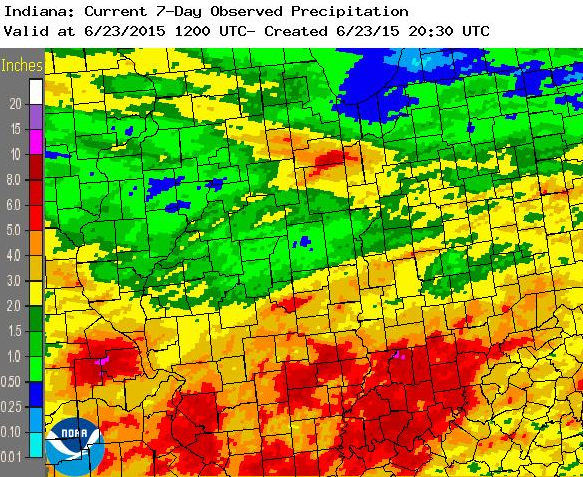Much of the state has seen excessive rains in recent weeks (Fig. 1). When soils are saturated vegetable crops suffer. This article, slightly revised from its original publication date in July 2003, describes and explains problems that are likely to occur.
Vegetable crops become stressed in waterlogged soils. Aboveground wilting, yellowing and death of leaves, and epinasty, or downward curling of leaves and stems are all responses to what is happening to roots. If we had a window into the soil we would see roots stop growing and root tips die due to lack of oxygen. Wilting occurs because roots in waterlogged soil do not conduct water as well and lack of new root growth limits water uptake, while the aboveground portion of the plant may continue to grow for a time even after the root has stopped. The root system just cannot supply water fast enough to prevent wilting. Nutrient uptake by the injured root system is also limited, which can partially explain leaf yellowing and death. Epinasty occurs because ethylene concentrations in the root increase, and this natural plant hormone causes downward curling of leaves and stems. The ethylene also stimulates production of air spaces in the root, and development of adventitious roots on the stem.
Damage from waterlogging is worse in warm soils than in cool soils. The demand for oxygen by roots and soil microbes is greater at higher temperatures, and so lack of oxygen leads to more injury in warm soils. Some damage to waterlogged roots is delayed until the soil dries out a little and oxygen is available again. At that time compounds formed during the waterlogged period react with oxygen to form even more damaging compounds. Because of this, root damage may increase after the soil is no longer waterlogged.
Water and nutrient uptake are not the only root functions inhibited by waterlogged soils. Shoot-promoting plant hormones, cytokinins and gibberellins, normally produced by the root are reduced. The lack of soil oxygen also results in changes in the availability of some mineral nutrients. For instance, manganese (Mn) is made more available, and in low pH soils the chance of manganese toxicity is increased. See Vegetable Crops Hotline No. 585 (June 26, 2014) for photo and more information on manganese toxicity.
What steps can a grower take to minimize plant stress from waterlogged soil? This is one time when foliar application of nutrients might be beneficial to offset the reduced root uptake. Up to 10 lb. of actual N per acre from urea, 28% nitrogen solution, or calcium nitrate can be applied at a time. Organic growers might choose to apply materials such as fish emulsion or liquid seaweed if the products meet criteria for food safety. For the next several weeks, manage irrigation (if available) with the awareness that the root system is probably below ‘normal’ size.
Reference:Marschner, H. 1995. Mineral Nutrition of Higher Plants. 2nd ed. Academic Press, New York. pp. 626-641.
